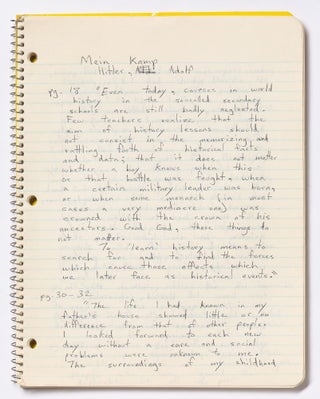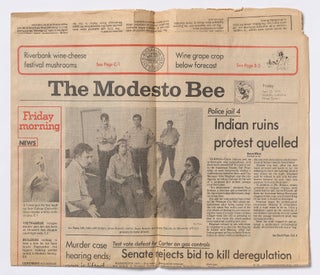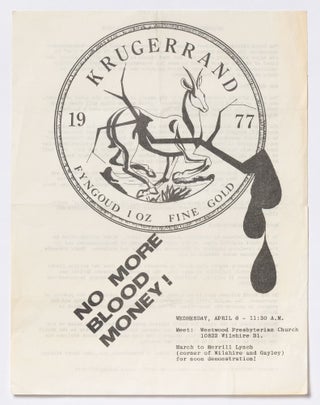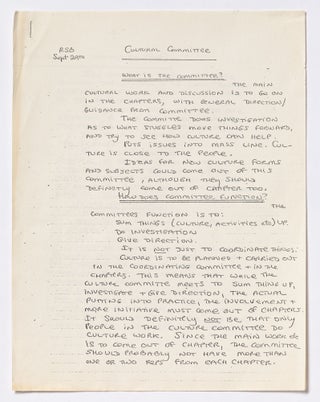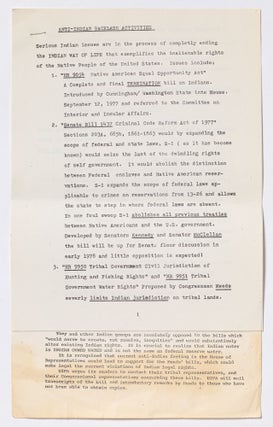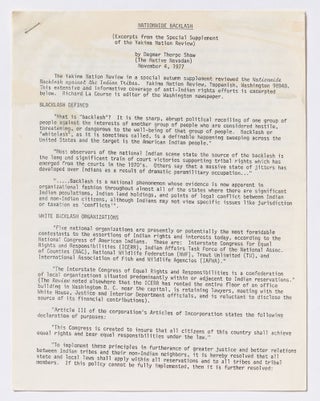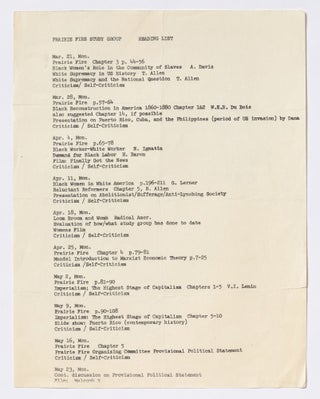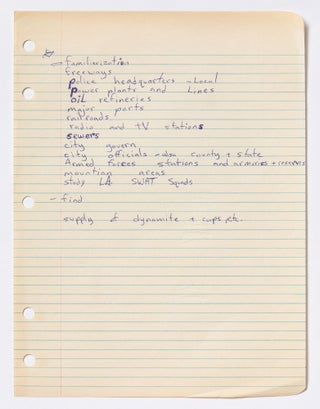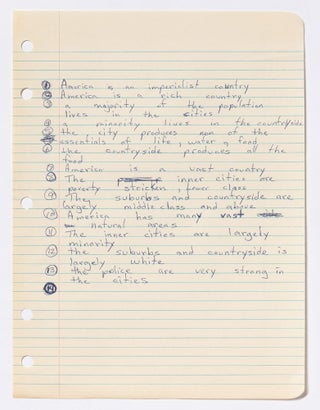California: 1974-1978.
Sold
Unbound. An archive of six commercial spiral bound handwritten notebooks (five quarto, one octavo). Two of the notebooks compose about 14,000 words of original narrative. The balance contain various related writings and research notes. As well as two 16mo. notebooks, one with notes, the other an address book. Also present are approximately 120 loose sheets of manuscript and printed material (notes, organizing material, arrest records, a newspaper issue, etc.). About ½ of a linear foot of material in total. Some mild handling wear, more so on the loose documents. Overall very good.
The archive of a revolutionary activist (b.1952) involved with numerous Native American protest movements and organizations throughout California (primarily Los Angeles and the Central Valley), consisting of several manuscript notebooks (including two narrative diaries), as well as dozens of loose sheets of manuscript and printed material and correspondence detailing his extensive readings, meeting attendance, organizing efforts (including names and addresses of organization members), protests, plans for urban guerrilla warfare, outlines and drafts of several manifestos, and the like.
He writes openly in the beginnings of his personal journals about his attraction to revolutionary movements, including the significant influence of the SLA (Symbionese Liberation Army), and specifically its members’ highly publicized (and televised) May 17, 1974 shootout with the LAPD: “Since I am just beginning this journal, I supposed it is incumbent on me to tell how and why I become involved in revolutionary politics. My active participation began after having seen the massacre in Compton on May 17 of this year. To sit in my living room and watch those people burn to death was too much. I kept hoping beyond hope that somehow they would get out alive, but I knew they wouldn’t. It was a very sickening thing. […] I emerged a revolutionary." (December 30, 1974).
His journals continue through 1974 to early 1977 in sporadic, often angst-filled entries on general philosophies of social movements, potential revolution, and personal issues (including a bizarre and prolonged romantic infatuation with a terminally ill young woman) — with a heavy emphasis on the study of the urban guerrilla warfare espoused by the SLA. The entirety of one notebook is devoted to this, including a section titled “Explosives and Guns,” replete with potential government and establishment targets for attack, sketches of machine guns, and a fiery, laid-in, open letter (dated June 11, 1975) titled, “A Message to the Pigs." In part: “This is a warning to all those policemen and other pig agents that might be out there polishing their guns, machine guns, and fire bombs, waiting to strike out at me and those of my kind at the first opportune moment. / When you come for me you had better grasp me tight, for I will not be taken quietly, like those revolutionaries of the sixties.”
While often alarmingly violent in nature, his early writings appear to us not terribly dissimilar to the typical musings of disillusioned radicalized college students, though with a few important distinctions. First, his motivations for study and pursuit of revolutionary activities seem largely internal, rather than guided by a professor, mentor, or social group. Further, there is an uncommon, working class point of view evident throughout the materials. Dates here have him well into his twenties, working full-time in construction, and living in Azusa, a San Gabriel Valley suburb of Los Angeles.
Importantly, however, the writer (originally from the Umpqua Region of Douglas County, Oregon near Roseburg) in several journal entries cites Native American ancestry. He becomes active in A.I.M. (American Indian Movement) and the Mohawk and Skyhorse Defense Committee, and he is pictured in the September 23, 1977 issue of *The Modesto Bee*, where he is identified as an “Indian” and member of the San Jose chapter of A.I.M.
Indeed 1977 was by far his most active year: leading security efforts for multiple protests, growing more intimate with A.I.M. leadership, attending meetings and participating in organizing efforts with the Prairie Fire Study Group (a Weather Underground-affiliated assembly), and visiting the campus of the newly formed D-Q [Deganawidah-Quetzalcoatl] University (one of the earliest tribal colleges) for an extended stay in early September. This last event culminates in his September 23, 1977 arrest, along with a number of other A.I.M. members, at a construction project which disturbed Native American burial grounds near Modesto. Much of the loose material documents this incident and his resulting lawsuit against the city for false arrest.
The materials gradually end in 1978, with the writer seemingly stranded in Pennsylvania — likely due to his participation in A.I.M.'s The Longest Walk. Nevertheless, a raw, rich, and revealing primary record from an active participant in Native American protest movements.
Item #423049



